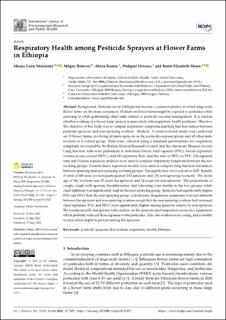| dc.contributor.author | Shentema, Meaza Gezu | |
| dc.contributor.author | Bråtveit, Magne | |
| dc.contributor.author | Kumie, Abera | |
| dc.contributor.author | Deressa, Wakgari | |
| dc.contributor.author | Moen, Bente Elisabeth | |
| dc.date.accessioned | 2022-07-05T11:14:17Z | |
| dc.date.available | 2022-07-05T11:14:17Z | |
| dc.date.created | 2022-07-04T15:38:31Z | |
| dc.date.issued | 2022 | |
| dc.identifier.issn | 1661-7827 | |
| dc.identifier.uri | https://hdl.handle.net/11250/3002733 | |
| dc.description.abstract | Background: Pesticide use in Ethiopia has become a common practice in which large-scale flower farms are the main consumers. Workers on flower farms might be exposed to pesticides while spraying or while performing other tasks related to pesticide use and management. It is unclear whether working as a flower farm sprayer is associated with respiratory health problems. Objective: The objective of this study was to compare respiratory symptoms and lung function indices between pesticide sprayers and non-spraying workers. Method: A cross-sectional study was conducted on 15 flower farms, involving all-male sprayers as the pesticide-exposed group and all other male workers as a control group. Data were collected using a standard questionnaire for respiratory symptoms developed by the British Medical Research Council and the American Thoracic Society. Lung function tests were performed to determine forced vital capacity (FVC), forced expiratory volume at one second (FEV1), mid 50 expiratory flow, and the ratio of FEV1 to FVC. Chi-squared tests and Poisson regression analyses were used to compare respiratory symptoms between the two working groups. General linear regression models were used to compare lung function test indices between spraying and non-spraying working groups. The significance level was set to 0.05. Results: A total of 285 male workers participated (152 sprayers and 133 non-spraying workers). The mean age of the workers was 25 years for sprayers and 24 years for non-sprayers. The proportions of cough, cough with sputum, breathlessness, and wheezing were similar in the two groups, while chest tightness was significantly high in the non-spraying group. Sprayers had significantly higher FVC and FEV1 than the non-spraying group. Conclusions: Respiratory symptoms were not different between the sprayers and non-spraying workers except that the non-spraying workers had increased chest tightness. FVC and FEV1 were significantly higher among sprayers relative to non-sprayers. The results must be interpreted with caution, as the sprayers used respiratory protective equipment, which probably reduced their exposure to the pesticides. Also, the workers were young, and a healthy worker effect might be present among the sprayers. | en_US |
| dc.language.iso | eng | en_US |
| dc.publisher | MDPI | en_US |
| dc.rights | Navngivelse 4.0 Internasjonal | * |
| dc.rights.uri | http://creativecommons.org/licenses/by/4.0/deed.no | * |
| dc.title | Respiratory Health among Pesticide Sprayers at Flower Farms in Ethiopia | en_US |
| dc.type | Journal article | en_US |
| dc.type | Peer reviewed | en_US |
| dc.description.version | publishedVersion | en_US |
| dc.rights.holder | Copyright 2022 by the authors | en_US |
| dc.source.articlenumber | 7427 | en_US |
| cristin.ispublished | true | |
| cristin.fulltext | original | |
| cristin.qualitycode | 1 | |
| dc.identifier.doi | https://doi.org/10.3390/ijerph19127427 | |
| dc.identifier.cristin | 2037082 | |
| dc.source.journal | International Journal of Environmental Research and Public Health (IJERPH) | en_US |
| dc.identifier.citation | International Journal of Environmental Research and Public Health. 2022, 19 (12), 7427. | en_US |
| dc.source.volume | 19 | en_US |
| dc.source.issue | 12 | en_US |

